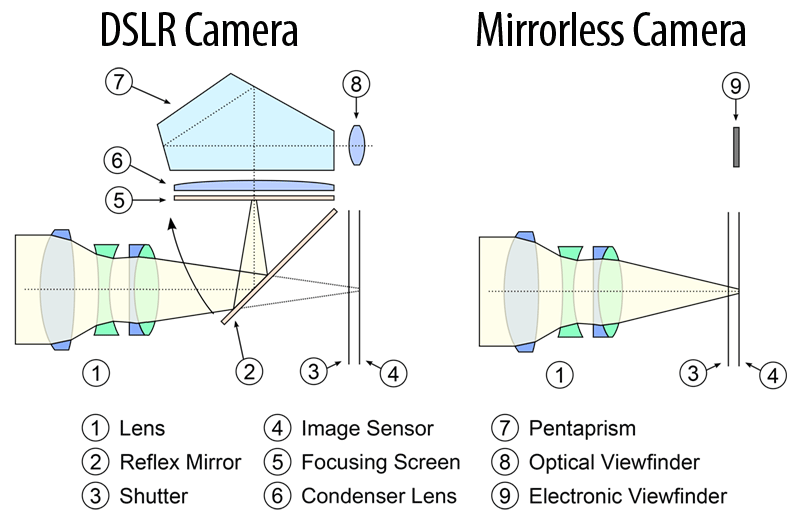What is a Mirrorless Camera?
What is a Mirrorless Camera?
While a DSLR camera uses a mirror mechanism to either reflect light into an optical viewfinder or pass it through directly to the camera sensor, a mirrorless camera completely lacks such mirror mechanism (hence the name), which means that the light passing through the lens always ends up on the imaging sensor. Since light is no longer reflected on an optical viewfinder (OVF), mirrorless cameras typically rely on electronic viewfinders (EVF) and LCDs that basically project what the imaging sensor sees. Because of the lack of a mirror mechanism and an optical viewfinder, mirrorless cameras can be made simpler, lighter, and less bulky when compared to DSLR camera.
Below is an illustration that shows the difference between a DSLR and a mirrorless camera:

As you can see, when compared to a mirrorless camera, a DLSR has a lot more components that make up the internals of the camera. Aside from the complex mirror mechanism, there is a focusing screen, a condenser lens, pentaprism / pentamirror and other components such as a secondary mirror and a phase-detection autofocus sensor that are present on a DSLR.
How Mirrorless Cameras Work
In contrast, a mirrorless camera is much simpler mechanically – light passes through the lens (#1) directly onto the image sensor (#4) and the optical viewfinder is replaced with an electronic viewfinder (#9) that replicates the image sensor. In normal operation, the mechanical camera shutter (#3) stays open and is only typically utilized at the end of exposure. Due to lack of both mirror and pentaprism, the flange distance (which is the distance between the lens mount and the image sensor) on mirrorless cameras can be shortened significantly, as the illustration above shows. Because of this, most mirrorless camera bodies are thinner and lighter compared to DSLRs.
Mirrorless cameras have many advantages over DSLR cameras. Aside from the potentially lighter weight and bulk of the camera itself, the use of an electronic viewfinder can bring many benefits to photographers. Since everything is duplicated directly from the image sensor, camera settings such as white balance, saturation and contrast can be seen through the viewfinder directly and additional information overlays including live histograms can be placed within the viewfinder, allowing photographers to see exactly what they are about to take a picture of. When combined with fast contrast-detection or on-sensor phase detection system, one can take advantage of being able to zoom in on a subject to verify focus, use focus peaking, face detection and other powerful features to ensure that focus is achieved precisely with every shot. When shooting in daylight conditions, one can utilize the electronic viewfinder to review images, instead of relying on the back LCD of the camera.
At the same time, mirrorless cameras have their list of disadvantages. First, the electronic viewfinder can only be active when the camera is turned on and power is provided to the image sensor, which can significantly affect the battery life of a camera. Second, electronic viewfinders can have noticeable lag, blackouts and high contrast, which can make it difficult for some photographers to get used to. When it comes to autofocus, although the latest mirrorless camera models can be very fast and accurate, they still do not do as well when shooting fast action, especially in low-light situations.
We wrote a detailed post that compares mirrorless cameras to DSLRs, so if you would like to find out more about the pros and cons of each, please take a look at our Mirrorless vs DSLR article. Explore the article of best cameras for movie production.
Note: If you want to make some adjustments to the photo just let me know. I can do it for you at a very low cost. You can hire me to edit your photo.







